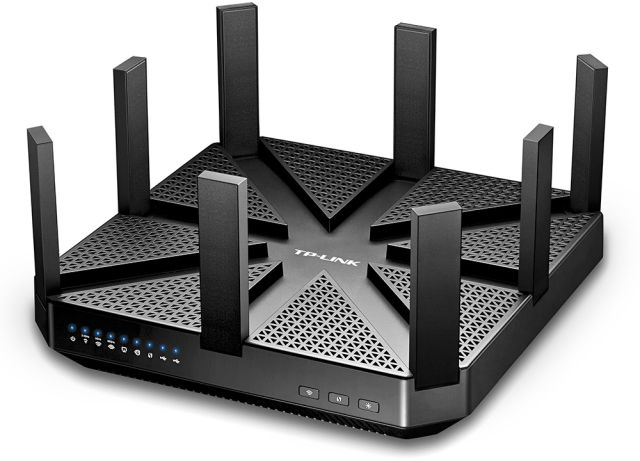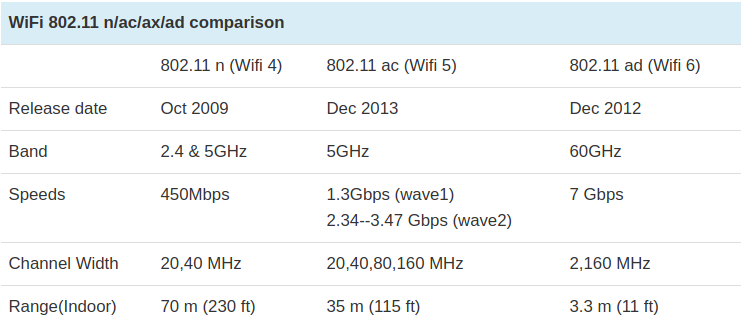WiFi 802.11 ac (Gigabit WiFi) or WiFi 5
Current WiFi standard is 802.11 ac also known as WiFi 5 is also called Gigabit WiFi simply because it supports over 1 Gbits/s transfer speeds. Released in December 2013 and succeeding 802.11 n announced in 2009, Gigabit Wifi or 802.11 ac operates in 5GHz frequency band only and has a range of only 35 m (115 ft). However, it’s common to find dual-band 802.11 ac routers which operate in both the 2.4 and 5 GHz frequency range. That’s because they support the older WiFi b/g/n versions. The current 802.11 ac supports transfer speeds of up to 1.3 Gbps with 3 spatial streams. Things get even more interesting when you learn that IEEE 802.11ac specification is further divided into two certification phases; Wave 1 and Wave 2. WiFi 802.11 ac Wave 2 announced by the WiFi alliance in 2015 supports an optional 160 MHz channel and MU-MIMO antenna formation which means you get speed boost of 2.34 Gbps (up from 1.3 Gbps) in the 5 GHz band. Related post: The updated guide to WiFi wireless network connectivity Some of the 802.11 ac routers on the market include ASUS RT-AC51U Dual-band Router, Belkin F9K1113 Dual-Band WiFi AC+ Gigabit Router, Linksys EA6500, TP-LINK TL-WDR7500, Netgear R6300. They typically range from a price of $120-500 depending on the features.
WiFi 802.11 ad (WiGig)
WiFi 802.11 ad also known as WiGig was developed by the Wireless Gigabit Alliance which was later merged into the mainstream body Wi-Fi Alliance in March 2013. WiGig promises multi-gigabit per second speeds over unlicensed 60 GHz frequency band unlike 802.11 ac which works on 5Ghz band. Related post: 5G WiFi: How to know if your smartphone supports this super fast wireless standard If you want to stream full HD movies, 2k or even 4K video from your streaming box to your laptop or smart TV, then you want to get yourself a 802.11 ad or WiGig router. The 802.11 ad standard achieves impressive theoretical speeds of 7 Gbps. However, be prepared for transfer speeds of about 4.6 Gbps in the real world situation. Of course you are better off with a tri-band enabled router which operates in 2.4, 5 and 60 GHz bands and is backward compatible so that even your older 802.11 b/g/n and ac devices can work. Related post: Single-Band vs Dual-Band vs Tri-Band Wi-Fi Routers: Which one should you buy? Some of the 802.11 ad routers aka WiGig routers currently on the market include the Acelink BR-6774AD – AD7200 WLAN Concurrent Tri-Band Gigabit Router, Netgear R9000 – Nighthawk X10 – AD7200 Smart WiFi Router, TP-LINK AD7200 (Talon) – AD7200 Multi-band Wi-Fi Router (802.11ac/ad). As you can tell, there are fewer 802.11 ad routers on the market than their 802.11 ac counterparts.
WiFi 802.11 ac vs 802.11 ad comparison
The major difference between WiFi 802.11 ac and Wifi 802.11 ad is that ac operates in the 5Ghz band while ad operates in 60Ghz. So ad’s higher frequency band gives it faster data transfer speeds of upto 7Gbps compared to ac’s 3.47Gbps. The other downside to WiGig is that while you achieve multi-gigabit speeds to stream 4K cat videos, the 60 GHz signal can’t penetrate walls but could propagate off reflections from walls, ceilings, floors and objects using beam-forming built into the WiGig system. WiGig also has a short range of only just 3m. So it’s best to use it within for instance a single room where there are not so many obstacles or walls.
WiFi 802.11 ac vs 802.11 ad vs ax comparison
WiFi 6 or 802.11 ax is the latest standard that is beginning to gain mainstream attention. It is a successor to 802.11 ac or WiFi 5. Unlike WiFi 5, the next generation of WiFi, 802.11ax or WiFi 6 operates in both 2.4Ghz and 5 Ghz band. WiFi 5 only works in 5Ghz band. That’s the main difference. However, most WiFi 802.11 ac routers are dual-band routers that support older 802.11 b/g/n standards giving them the ability to operate within both 2.4Ghz and 5Ghz bands. Now WiFi 6 is a lot faster than 5. It boosts roughly 10-14 Gbps transfer speeds using four 160MHz channels given that each stream is capable of 3.5Gbps where as WiFi 5 tops about 4Gbps with wave 2. WiGig operates in 60GHz band with speeds of upto 7Gbps. Modern routers usually support one or more standards and these are dual-band or tri-band routers. There are plenty of WiFi 6 routers now in the market and you can take a look at our compilation. Read more: Single-Band vs Dual-Band vs Tri-Band Wi-Fi Routers: Which one should you buy? There’s no doubt that 802.11 ac is a lot more popular than 802.11 ad, but if you are serious about very high wireless speeds over a short range, then you want to consider 802.11 ad. But if you want are good with simply Gigabit speeds over walls then 802.11 ac is your friend. If you want a mixture of both, remember that there are dual or even tri-band routers that support two or more standards at once. Image: pickmyrouter.com





